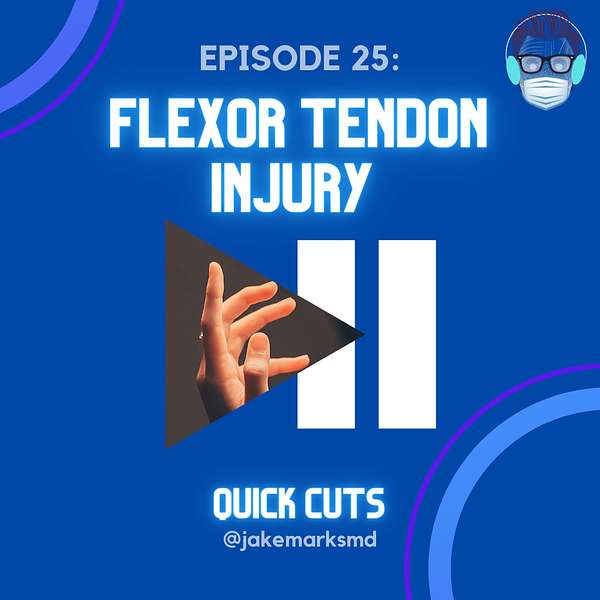
Quick Cuts: A Plastic Surgery Podcast
Quick Cuts: A Plastic Surgery Podcast
Episode 25: Flexor Tendon Injury
A rapid review of flexor tendon injury for the plastic surgery learner. In this episode we review:
- Flexor tendon anatomy
- Evaluation and management of the flexor tendon injury patient
Feedback is always appreciated. Comments, questions, suggestions, or corrections can be sent to jakemarksmd@gmail.com
References:
- Kamal RN, Yao J. Evidence-Based Medicine: Surgical Management of Flexor Tendon Lacerations. Plast Reconstr Surg. 2017;140(1):130e-139e.
- Tang JB. Flexor Tendon Injuries. Clin Plast Surg. 2019;46(3):295-306.
Hey everyone and welcome back to Episode 25 of Quick Cuts: A Plastic Surgery Podcast. On today's episode, we discuss flexor tendon injury. So let's get started. And we'll start with a review of the relevant anatomy. The extrinsic flexors of the fingers and wrist include the flexor digitorum superficialis, the flexor digitorum profundus, flexor pollicis longus, flexor carpi radialis and flexor carpi ulnaris, and the palmaris longus. As the digital flexor tendons enter the fingers, specifically the FDS, FDP and FPL. They pass through a series of pulleys that create mechanical advantage by keeping the tendons approximated to the phalanges and preventing them from bowstringing during flexion. In the index, long, ring, and small fingers There are five annular pulleys referred to as A1 through A5 and three cruciate pulleys referred to as C1 through C3. Of these pulleys, A2 and A4 are often considered the most important in preventing bowstringing. The thumb is somewhat unique in that there are three annular pulleys A1, Av, and A2, and one oblique pulley. In order to classify flexor tendon injuries, we often describe their location in terms of flexor tendon zones of injury. A zone one injury occurs distal to the insertion of the FDS tendon. Zone two injury occurs between the distal insertion of the FDS tendon and the distal palmar crease. Zone three injuries are located between the distal palmar crease and the distal edge of the transverse carpal ligament. Zone four injuries occur within the carpal tunnel and zone five is proximal to the carpal tunnel. In the thumb, zones one through three are slightly modified zone T1 occurs distal to the IP joint. Zone T2 between the A1 pulley and the IP joint. And zone T3 describes the thenar eminence. We'll talk next about the evaluation and management of a patient with an acute flexor tendon injury. In addition to your general medical history, you should determine the patient's hand dominance, occupation, and mechanism of injury. On physical exam, you should perform a comprehensive hand exam. You can evaluate specifically for flexor tendon injury by observing the hands resting posture, and assessing for normal digital cascade. Digits with flexor tendon injuries will often rest in extension. You should also assess tenodesis with passive flexion and extension of the patient's wrist. An intact flexor tendon will generally result in flexion of the MCP, PIP, and DIP joints with extension of the wrist. In addition to passive motion, active motion of the DIP and PIP joints should be tested in isolation for each finger. Physical exam alone is usually sufficient for diagnosis, although ultrasound or MRI can be considered in select cases. In regards to treatment, operative repair is indicated for complete lacerations of the tendon and partial lacerations that involve 60% or greater of the tendon width. Tendon repair is ideally performed within three weeks of the injury. As beyond this point in time, scarring and tendon retraction as well as adhesions may make repair difficult. Splinting the patient until definitive repair is often performed to help reduce tendon retraction. A number of techniques have been described for flexor tendon repair and detailed discussion is beyond the scope of today's podcast. That being said, there are several principles to understand regarding flexor tendon repair. Repair of an acutely lacerated tendon is generally performed in a primary end to end fashion. The ideal primary repair provides adequate strength to prevent rupture with minimal bulk allowing for smooth tendon gliding. Probably the most significant factor in repair strength is the number of core strands, or the number of suture strands that actually cross the repair site. Repair strength has been shown to increase with increased number of core strands, with four or six strand repairs being the most commonly used. A circumferential epitendinous suture can also be used to further strengthen the repair. Increased suture caliber has also been shown to strengthen repairs. But it's also important to remember that increased suture caliber along with increased number of core strands increases bulk of the repair, which ultimately may inhibit tendon gliding. Additional technical pearls used to optimize the repair strength include dorsal suture placement, the use of locking versus grasping suture loops, suture purchase 7 to 10 millimeters from the cut end of the tendon and avoiding gapping at the repair site. Venting of the pulleys adjacent to the repair can also be performed to allow for improved tendon gladding postoperatively patients are commonly placed in a dorsal blocking splint, postoperatively and early active motion rehabilitation protocols are favored. Passive motion protocols or complete immobilization are generally reserved for non-compliant patients or those with weak repairs. Complications of flexor tendon repair include adhesion formation, rupture at the repair site, and joint contractures. For failed primary repairs and or chronic injuries, staged tendon reconstruction is often indicated. And that ends our discussion on flexor tendon repair. If you're continuing to enjoy the podcast, please subscribe so you don't miss new episodes. You can find my entire audio library along with great online content at theplasticsfella.com. For questions, suggestions or feedback about the podcast You can reach me at jakemarksmd@gmail.com otherwise, you can find me on Instagram or Twitter @JakeMarksMD. Thanks for listening. See you next time.